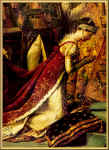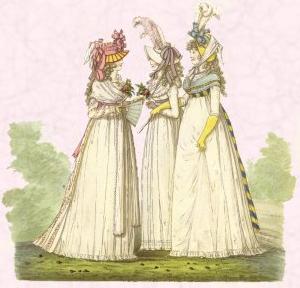Any account of historical Indian costumes runs into serious difficulties not for want of literary evidence or of archaeological and visual materials: of both of these there is a fair measure that is available. The difficulty arises when one tries to collate the information that can be culled from these sources. The descriptions in literary works, for all their great poetic beauty and elegance, are, in the nature of things, not precise and one has to guess and reconstruct. Sometimes the descriptions are so general that they can fit more than one costume quite different from each other. All this is not to say that a broad, general idea cannot be formed of the kinds of costumes worn in the ancient, medieval or the late medieval periods in India. What one is denied is the possibility of going into the many subtleties that Indian costumes possess. Their range is remarkably wide, according to the great size of the country, and geographical differences, and the bewildering diversity of its ethnic groups is added the complex factor of the coming in, at regular intervals, of foreign peoples into India at different periods of time and in varying numbers. The costumes that these people brought along did not stay necessarily apart from the mainstream of Indian dresses - that one could have dealt with - but, with the Indian genius for adaptation and modification, these costumes become altered, even metamorphosed, and eventually assimilated to the broad, native Indian range of dress. One has, therefore, to sift and isolate, and then relate and bring together, the evidence available which is not the easiest of tasks in the context of Indian history where material culture does not always get the attention it does elsewhere. Through sharp analysis of Sanskrit, Prakrit, and Hindi, as much as Arabic and Persian sources, they have brought within reach a rich body of material. The inherent difficulty in the matter of interpreting this material and relating it to surviving archaeological and visual evidence naturally leaves some matters obscure, and others open to controversy. But a very substantial body of information has been collected.
A question that needs to be disposed of rather early is whether, in the indigenous Indian tradition, stitched garments were known or used at all. From time to time statements have been made that the art of sewing was unknown to the early Indians, and that it was an import from outside. Serious and early students of Indian costumes, like Forbes Watson, have stated, mostly on the authority of other scholars, that the art of sewing came to India only with the coming of the Muslims.' This statement needs no longer to be taken seriously. As has been established, not only was the needle and its use known to Indians from the very beginning of the historic periods that we know of; the art of sewing was practised, and one comes upon clear and early references to stitched garments that leave very little doubt about the matter.' It is possible that the view that "before the invasion of India by the Mohammedans, the art of sewing was not practiced there" was formed not on the basis of any historical or scholarly inquiry into this matte but simply 'observation': observation of the dresses of two different categories of people, those who were far more rooted in the Indian soil and could thus be taken as representing the long Indian tradition of wearing costumes in a particular fashion, and those who could be linked with outsiders' who came to India late, and visibly preferred different kinds of dresses. This observation could only have been superficial; besides, clear distinction needs to be made between the knowledge of, and the use of, sewing. It is possible perhaps also to draw a distinction between what, in the Indian context, can be designated as "timeless" costumes, and those that are time bound". The 'timeless' Indian dress of men, thus, consists of garments that use no stitching, garments in other words that, as Forbes Watson says, "leave the loom, ready for wear". The Dhoti, the Scarf or Uttariya, and the Turban, which have never really disappeared from any part of India, belong to this category, and their marked visibility in India could have led one erroneously to conclude that the early Indians did not use any sewn garments. Likewise, for women, the Dhoti or the Sari as the lower garments, combined with a Stanapatta or breast-band for covering the breasts, forms a basic ensemble, and once again consists of garments that do not have to be stitched, the breast garment being simply fastened in a knot at the back. And the Dhoti or the Sari worn covering both legs at the same time or, in the alternative, with one end of it passed between the legs and tucked at the back in the fashion that is still prevalent in large area of India.
But the preference of Indian men and women for these garments, rational and understandable in the context of the generally hot Indian climate, does not afford any proof that for long periods of time the Indians knew no other garments than those which "left the loom, ready for wear".
It is not easy to make out everything in Alberuni's description, but there is little doubt that he is referring to a dhoti when he speaks of 'turbans used for trousers', and a kaupina when he is speaking of 'a rag of two fingers' breadth bound over the loins. But the amusing reference to 'trousers lined with as much cotton as would suffice to make a number of counterpanes and saddle rugs' is not easy to make out. Possibly he is referring to dhotis of considerable length and fullness that were tucked between the legs and at the waist behind.
Similar problems arise with the accounts of Chinese writers. Wherever they speak of costume, not too much is added to our information although there is much precision and detail when it comes to their description of the trade in textiles from different parts of the country. This is understandable because one of the principal concerns of the many travellers to India was trade precisely of this kind, sometimes in these very materials. All the same, the information made available is not without interest, and one notices carefully the comment of someone like Chau j ' u-kua, the inspector of foreign trade in Fu-kien in the 12th century, concerning the dress worn by the ruler of Malabar: -"The ruler of the country has his body draped, but goes bare-footed. He wears a turban and a loin-cloth both of white cotton cloth. Sometimes he wears a white cotton shirt with narrow sleeves".
The period of the Sultanates in northern India is marked, once again, by much interest, both on the part of the Indian writers, and of the newly arrived Muslims in matters concerning fabrics and dyes and costumes. But the earlier difficulty of accurately interpreting this information persists, for even though long lists become available, these remain confined to names for which we have no pictorial equivalents in the matter of costumes, and no analytical descriptions in respect of fabrics and the like - in the paintings from the Sultanate period, an area in which our knowledge has increased remarkably in the last quarter of a century or so, there is much that one can observe, but to give precise names to costumes still remains difficult. One can at best try and find relationships between terms for costumes or verbal descriptions, and the dresses that we see men and women wearing in Sultanate period paintings, whether of the Indo-Persian style or those that we associate with western India, principally Jaina paintings produced in Gujarat and Rajasthan. When one makes the effort, however, interesting results sometimes emerge. Thus, in the paintings of the Laur Chanda in the Prince of Wales Museum of Bombay, or the Aranyaka Parva of the Asiatic Society of Bombay, or the recently discovered Devi Mabatntya in the Himachal Pradesh Museum at Simla, the long-sleeved kutia-like garments made of fine cotton material, with fastenings at the right or the left, come remarkably close to the early description by Alberuni of the kurtakas worn by Indians which have lappets with 'slashes' both on the right and the left sides. But this kind of close correspondence is not always easy to establish in other articles.
The Varna-ratnakara of jyotirishvara of the early 14th century, the Prithvichanda-charita also of the 14th or 15th century, and the compilation by Sandesara, the Varnaka~Samuccaya, have remarkably long and detailed lists of stuffs known to India in that period, but there is no correspondingly detailed information on costumes. An interesting development at the same time is that certain Persian writers,- including Amir Khusrau, begin using Hindi words, or words of the vernaculars, in their descriptions of Indian fabrics. in his usual engaging style, thus, Khusrau speaks of 'cloths that redeem the past life, decoration of the person and ornament of the body likejbanbariali and bibari - that are like a pleasant gift of a springtide and sit as lightly on the body as moonlight on the tulip or dew drops on the morning rose'. Khusrau's enthusiasm for Indian fabrics, especially the fine muslin's manufactured in Deogiri, far exceeds his notions of precision in the matter of description, but whatever he says is never without interest. Thus, writing of Deogiri in A.D. 1322, he says:" 12
The fineness of its cloths is difficult to describe; the skin of the moon removed by the executioner star would not be so fine. One would compare it with a drop of water if that drop fell against nature, from the fount of the sun. A hundred yard of it can pass the eye of a needle, so fine is its texture, and yet the point of the steel needle can pierce through it with difficulty. It is so transparent and light that it looks as if one is in no dress at all but has only smeared the body with pure water.
When it comes to a description of the costumes worn by the Sultans or the notables at any of the Islamic courts of north India, the flavour changes completely, for the writers, nearly all of them Muslims of foreign extraction, suddenly seem to move into a world of terms and articles that they are familiar with. Thus, while ibn Batutah might write in very general terms of the costumes worn by Indian women ('the women of this city and of the whole coast do not wear sewn cloths but only unsewn garments. They form a girdle with one of the extremities of the garment and cover their heads and breasts with the other.), the description by Umari of the dresses worn by the notables of Delhi suddenly becomes animated and more vivid:"
The linen garments which are imported from Alexandria and the land of the Russians are worn only by those whom the Sultan honours with them. The others wear tunics and robes of fine cotton. The make garments with this material which resembles the robes (makati) of Baghdad. But these latter as also those called wasafi differ very much from those of India as regards fineness, beauty of colour and delicacy.
Most of their Tartar (Attar) robes are embroidered with gold (muzarkasa bi-dhabab). Some wear garments with both sleeves having a tiraz border of gold embroidery (zarkasb). Others, for example the Mongols, place the tiraz inscription between the shoulders.
It is in this very strain that we have other descriptions from this period, Firuz Shah T'Ughlaq and his courtiers wearing different kinds of dresses. The Sultan himself is said to have worn a kulab costing a lac of tankas which once belonged to his predecessor. In public audience, he is said to have worn a barani with embroidered sleeves, but in private he wore a shirt. The officers are said to be wearing silken robes in public and shirts in private life. Again the Amirs and the Maliks and other officers at the Sultanate courts are described as wearing "gowns (tatailyat),jakalwat and Islamic qabas of Khawarizm tucked in the middle of the body" and short turbans which did not exceed five or six forearms. Of other Amirs we learn that they were as well dressed "as the soldiers except that they did not use belts and at times they let down a piece of cloth in front of them after the manner of the sups. The judges and the learned men wore ample gowns (farajiyat) that resembled jaradiyat (striped material from jand, Yemen) and an Arabic garment (durra) (a garment opening in front and buttoned)





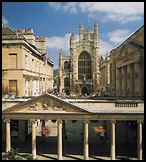
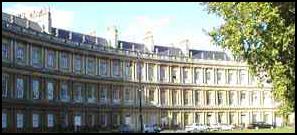 Make up usually made of lethal ingredients was discarded. Hair powder was abandoned for fresh clean washed cropped hairstyles. Blatant use of jewellery was soon seen as vulgar and outdated.
Make up usually made of lethal ingredients was discarded. Hair powder was abandoned for fresh clean washed cropped hairstyles. Blatant use of jewellery was soon seen as vulgar and outdated. Their roles are played out in the drawing room, the assembly room, the Parsonage or Rectory, the fashionable street for promenading, or the grounds of the country house.Her characters spend their time reading, writing letters, walking, riding, dancing, playing cards, listening to music and enjoying the art of conversation. Their conversation speaks of their own safe and comfortable society. They talk about fashion and taste, about acceptable manners and unacceptable behaviour. Above all else, their conversation concentrates on thoughts of love and marriage. Their mothers despair for the lack of suitable suitors.
Their roles are played out in the drawing room, the assembly room, the Parsonage or Rectory, the fashionable street for promenading, or the grounds of the country house.Her characters spend their time reading, writing letters, walking, riding, dancing, playing cards, listening to music and enjoying the art of conversation. Their conversation speaks of their own safe and comfortable society. They talk about fashion and taste, about acceptable manners and unacceptable behaviour. Above all else, their conversation concentrates on thoughts of love and marriage. Their mothers despair for the lack of suitable suitors.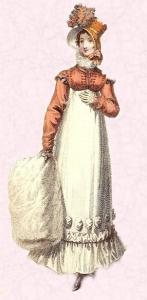
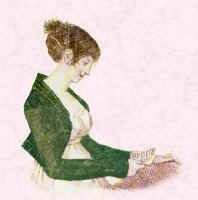
 The high waisted graceful styles of early 19th century are known as the Empire style. The Empire dress which evolved in the late 1790s began as a chemise shift gathered under the breasts and at the neck.
The high waisted graceful styles of early 19th century are known as the Empire style. The Empire dress which evolved in the late 1790s began as a chemise shift gathered under the breasts and at the neck. 
